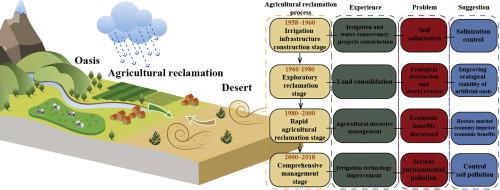Agricultural Systems ( IF 6.1 ) Pub Date : 2021-07-09 , DOI: 10.1016/j.agsy.2021.103220 Tianyu Wang 1, 2 , Zhenhua Wang 1, 2 , Li Guo 3 , Jinzhu Zhang 1, 2 , Wenhao Li 1, 2 , Huaijie He 1, 2 , Rui Zong 1, 2 , Dongwang Wang 1, 2 , Zhecheng Jia 1, 2 , Yue Wen 1, 2

|
CONTEXT
An artificial oasis is a desert area suitable for human occupation and agriculture by human management. Agricultural reclamation in artificial oases provides a means for population growth and urban expansion in arid regions, but it comes at an environmental cost.
OBJECTIVE
Xinjiang is a largely arid region in northwest China, in which agricultural cultivation is concentrated in piedmont oases. Xinjiang's agriculture expansion has placed it as the largest cotton and grape producing area in China. This study seeks to understand better the successes and challenges facing oasis agriculture and propose possible solutions.
METHODS
Through field investigation, experiments, and data collection, we reviewed a typical case of agricultural development over the past 60 years in the Mosuowan irrigation area of Xinjiang. We summarized the experiences and problems that emerged and then put forward some suggestions.
RESULTS AND CONCLUSIONS
We identified four factors that are critical for successful agricultural development: (1) irrigation infrastructure and water conservancy projects; (2) land consolidation; (3) intensive agricultural management; and (4) irrigation technology improvements. After nearly 60 years of rapid agricultural reclamation, we identified several challenges in sustainable agricultural development: (1) soil salinization; (2) ecological and environmental deterioration; (3) declines in economic benefits; (4) and soil and environment pollution. We propose the following measures that may feasibly address these concerns, respectively: (1) comprehensively harness saline-alkali land by means of improvers, biological methods, and drainage infrastructure; (2) establish desert-oasis ecological buffer zones; (3) adjust agricultural management policies; (4) and improve plastic recycling or degradability and adjusting irrigation and fertilization strategies to reduce soil pollution.
SIGNIFICANCE
Oasis agriculture is a complex and fragile system, and its sustainable development needs to be rooted in scientific management. We hope that our review can provide some reference for agricultural development in similar areas.











































 京公网安备 11010802027423号
京公网安备 11010802027423号